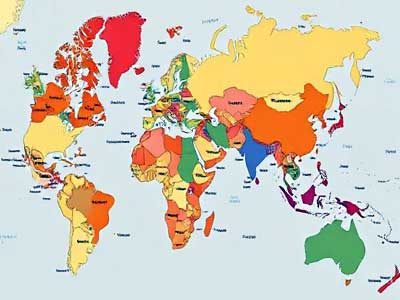At a time when India is facing hostilities from across the borders and surrounded by not-so-friendly neighbours, scholars are wondering whether nations, small in size and with limited resources, have any future, or will they permanently remain basket cases.
In an era of rapid technological advancement and globalised markets, small, resource-poor nations risk becoming permanent liabilities—economic basket cases trapped in cycles of stagnation. With limited skilled labour, weak capital bases, and tiny domestic markets, these economies struggle to compete, often relying on aid or remittances while engaging in petty regional conflicts.
Read in Hindi: वैश्वीकरण की दुनिया में देशों के ‘आकार’ की कठोर सच्चाई
The solution? Evolution through integration. Instead of clinging to fragmented sovereignties, these nations should merge into larger economic blocs, pooling resources, dismantling trade barriers, and creating shared infrastructure. A unified market would attract investment, foster innovation, and amplify collective bargaining power.
History shows that isolation breeds decline, while integration fuels prosperity. The future belongs to agile, collaborative entities, not microstates fighting over scraps. It’s time for small economies to shed outdated nationalism, embrace strategic unity, and secure their survival in a hyper-competitive world. The alternative is irrelevance.
Despite the promise of technology to level the playing field, smaller or resource-poor nations find themselves more vulnerable than ever. Without a critical mass of land, people, natural resources, and capital, the chances of self-sustaining development dwindle. Nations like Pakistan, Bangladesh, Sri Lanka, Maldives, Nepal and several in Sub-Saharan Africa are stark examples of the existential challenges posed by insufficient scale.
Many smaller nations suffer from structural weaknesses—limited natural assets, small internal markets, and fragile institutions—that hinder long-term planning and resilience. Pakistan, with a population nearing 250 million but plagued by poverty (over 42 per cent in 2025), lacks the industrial depth or capital reserves to tackle rising inflation, joblessness, or climate threats. Bangladesh, despite its economic growth, relies heavily on low-wage garment exports that are increasingly at risk from automation and shifting global trade norms.
In Sri Lanka, a nation already reeling from political instability and debt default, tourism and agriculture, two key sectors, are acutely vulnerable to global shocks. The Maldives, with its scant landmass and high dependency on imports, faces the twin threats of sea-level rise and economic marginalisation. These nations illustrate how limited geographic and economic scale can severely restrict strategic depth, development flexibility, and bargaining power on the world stage.
Unlike vast and resource-rich nations such as Russia, the US, or even Brazil, many smaller countries lack the natural capital—oil, minerals, forests, freshwater—that can be leveraged for development or diplomacy. This puts them at a severe disadvantage in attracting foreign investment or building resilient economies. Chad and Mali, for instance, remain dependent on rain-fed agriculture, rendering them highly susceptible to climate variability and food insecurity.
In countries like Malawi or Lesotho, ecological degradation, poor soil quality, and limited arable land amplify the risks of undernutrition and mass migration. Without scale, these nations struggle to absorb shocks—whether economic, environmental, or geopolitical.
A lack of scale also translates into limited capital accumulation and an underdeveloped human resource base. Smaller or poorer nations often experience severe brain drain as skilled professionals emigrate in search of better opportunities. The African Union estimates that over 70,000 skilled professionals leave the continent each year, hollowing out domestic institutions.
Pakistan’s tight fiscal constraints have led to dismal public investment, weakening health, education, and infrastructure. In Bangladesh, the workforce is large but largely unskilled, which restricts upward mobility in the global value chain. These deficits leave such nations reliant on external aid, which comes with strings attached—IMF and World Bank loans that often mandate austerity, further undermining social cohesion.
For small and vulnerable nations, climate change isn’t a distant threat—it’s a current crisis. Rising seas could engulf island states like the Maldives within decades. Bangladesh faces intensified cyclones and flooding that displace millions and disrupt food production. In the Sahel region of Africa, desertification and water scarcity are already triggering violent resource conflicts.
While adaptation is technically possible, it requires enormous capital—something most small nations simply don't have. International climate finance has fallen short of its promises, leaving these countries to fend for themselves.
The global economic system often rewards scale. Nations with large domestic markets—like India or China—can absorb shocks better, attract more foreign direct investment, and use state capacity to shape global rules. Smaller nations, lacking this heft, become price takers rather than price setters in trade, and often find themselves trapped in unequal economic relationships.
Automation and AI are replacing low-skill labour, threatening key export sectors like garments, customer service, and agriculture in countries like Bangladesh and the Philippines. Without the technological base or capital to upskill their workforce, these nations risk exclusion from the digital economy altogether.
International lending institutions like the IMF and World Bank offer temporary breathing room through loans and debt restructuring. But these interventions are no substitute for internal resilience. Austerity measures often deepen poverty and spark unrest, as seen in Sri Lanka’s 2022 crisis or Pakistan’s recurring debt traps.
Ultimately, loans cannot compensate for a lack of size, whether in land, people, or economic complexity. In a hyper-connected yet brutally competitive global landscape, the size of a nation remains a foundational determinant of its future. Large countries enjoy strategic depth, market power, and the ability to diversify their economies. They can better absorb shocks, attract investment, and assert themselves on the global stage.
For smaller nations, survival increasingly hinges on forming strong regional alliances, investing heavily in human capital, and securing climate resilience funding. But without structural reforms and significant international support, many risk becoming permanent casualties of a warming, unequal, and volatile world order.
In geopolitics, size may not be everything, but without it, everything becomes harder.

















Related Items
Sudharma, A bridge between tradition and the future...
Trump’s Conspiracy: India’s Trap or Golden Opportunity?
India’s chaotic and undisciplined progress…